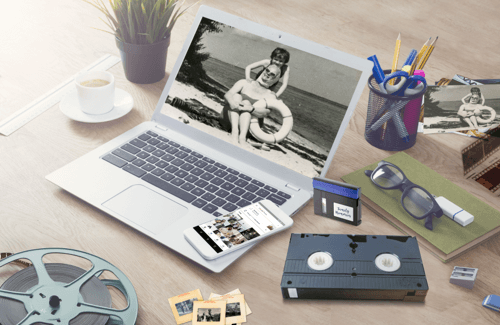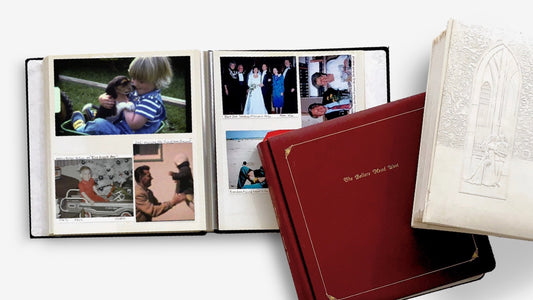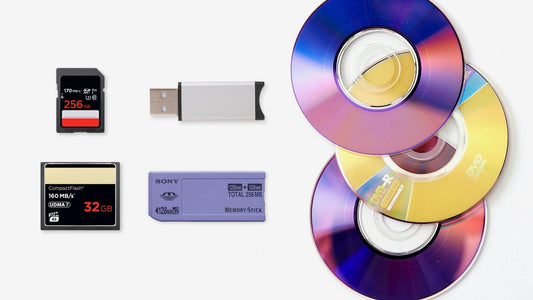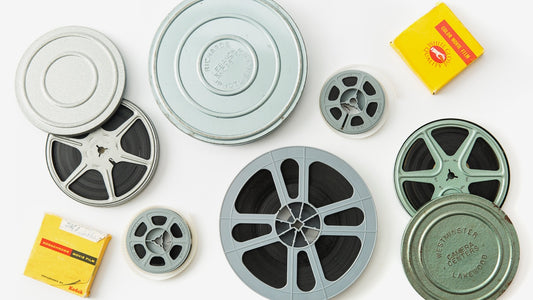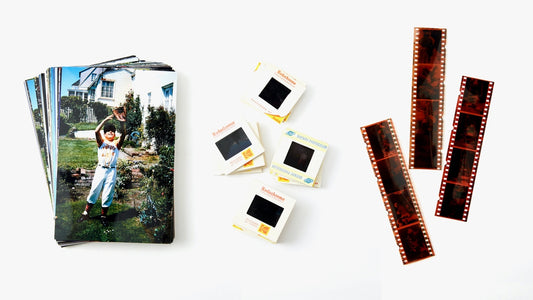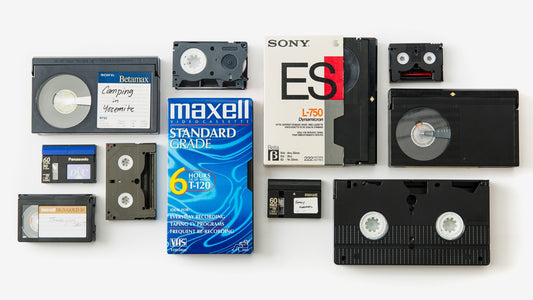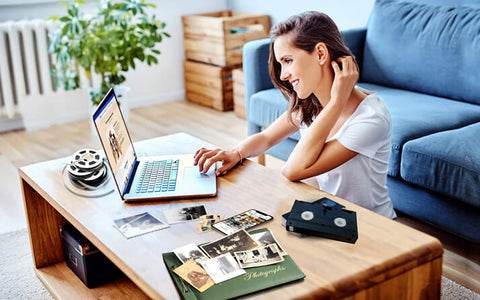Your wedding video, your child's first steps, those hilarious family vacations—they're all on VHS tapes, likely gathering dust in a closet. But those tapes are fragile. With each passing year, the magnetic tape degrades, and the memories they hold become a little fuzzier. It's time to rescue them. The best way to do this is to digitize VHS tapes, converting them into a modern format you can actually watch and share. This guide provides a clear, step-by-step approach, covering everything from choosing the right service to preparing your tapes for the journey.
Key Takeaways
- Preserve your memories by converting VHS tapes to digital formats. Digitization protects fragile tapes from degradation and allows easy sharing with loved ones.
- Select a digitization service that prioritizes quality, security, and clear communication. Research different providers, compare pricing and services, and check customer reviews before making a decision.
- Properly preparing your tapes ensures a smooth digitization process. Check for damage, organize and label clearly, and package securely for shipping to protect your irreplaceable home movies.
Why Should You Digitize Your VHS Tapes?
Why Should You Digitize Your VHS Tapes?
Remember those family vacations, birthday parties, and holidays captured on VHS tapes? Those precious moments are worth protecting, and digitizing your VHS collection is the best way to do it. Let's explore why making the switch from analog to digital is so important.
Save Your Memories Before They Disappear
Time takes its toll on everything, and VHS tapes are no exception. They degrade over time, risking the permanent loss of your precious footage, as highlighted by Consumer Tested Reviews. Converting those aging tapes to digital formats like MP4s offers a solution, transforming them into easily accessible and shareable memories, according to YesVideo's VHS Conversion Guide. Think of it as giving your memories a refresh—a chance to relive those special moments for generations to come.
The 15-Year Lifespan of VHS Tapes
It's a tough reality to face, but VHS tapes weren't built to last forever. The magnetic tape inside them starts to degrade over time, a process that can become noticeable after about 15 years. This isn't just a small dip in quality; we're talking about colors fading, sound becoming distorted, and the tape itself growing brittle and prone to snapping. Every year that passes makes it more likely that your wedding video or your baby's first steps could be lost for good. That's why it's so important to consider a professional video transfer to safeguard those irreplaceable moments before they fade away completely.
That 15-year mark is just a guideline; factors like how you've stored your tapes can speed up their decline. Tapes kept in a hot attic or a damp basement are likely to degrade much faster. The magnetic particles that hold your video information can lose their charge over time, leading to that fuzzy "snow" or static on the screen. Unfortunately, this is a one-way street—once the quality is gone, you can't get it back. Digitizing your collection is the only way to halt this decay in its tracks, creating a permanent, high-quality copy that you can easily share and enjoy without worrying about it disappearing.
Easily Share and Watch Your Home Movies
Digitizing your VHS tapes isn't just about preservation; it's about making your memories easier to enjoy. No more bulky VCRs or tangled wires! YesVideo, a leader in home video conversion, transforms old tapes into digital files and DVDs viewable on your computer, TV, smartphone, or tablet. Imagine easily sharing those precious moments with family and friends, creating new memories as you reminisce together. A digital copy also provides a secure backup, ensuring your memories are safe even if something happens to the original tapes, as noted by Walmart.
Want to relive those family vacations, birthday parties, and holiday gatherings captured on VHS tapes? Digitization is the answer. It's the process of converting those old analog recordings into digital files that you can easily watch on modern devices and share with loved ones. This section breaks down how it all works.
How Does VHS Digitization Actually Work?
VHS conversion offers a solution, transforming those aging tapes into easily accessible and shareable digital formats like MP4s. The process involves playing your VHS tape on a VCR while simultaneously capturing the audio and video output using a specialized device called a video capture card. This card converts the analog signal into a digital format, which is then saved onto a computer or other storage device. Professional services, like YesVideo, use high-quality equipment and techniques for clearer videos, maintaining the integrity of your footage. YesVideo, for example, captures VHS transfers at 720x480 resolution, ensuring your memories are preserved in the best possible quality.
Should You DIY or Hire a Professional Service?
You have two main paths for digitizing your VHS tapes: doing it yourself (DIY) or using a professional service. Both have their pros and cons, so let's explore each option. The DIY route might seem appealing for its potential cost savings. A DIY setup typically involves purchasing a video capture card and connecting it to your VCR and computer. However, the quality of DIY digitization depends heavily on the equipment and techniques used. Many find that cheaper converters produce inferior results, and the process can be time-consuming, especially if you have a large collection of tapes. For the best quality DIY results, some users on Reddit recommend RF capture methods using devices like the Domesday Duplicator or CX cards, along with specific software. This approach captures the raw signal, allowing for superior post-processing, but it requires technical expertise. Plus, a DIY solution costs around $200 upfront.
Professional services, while generally more expensive (ranging from $20–$30 per tape, depending on the provider), offer convenience and high-quality results. Companies like YesVideo and Legacybox handle the entire process for you, from receiving your tapes to delivering the digitized files in your preferred format. This eliminates the hassle of setting up equipment and troubleshooting technical issues. If you have a significant number of tapes to convert, the upfront cost of professional digitization might be comparable to investing in high-quality DIY equipment. Ultimately, the best choice depends on your technical skills, budget, and the number of tapes you need to convert.
The Complexity of the DIY Process
Going the DIY route can feel empowering, but it’s often more complex than it first appears. Many who attempt it describe the process as a "rabbit hole" because it requires a significant investment of both time and patience. You're not just pressing a button; you're becoming a part-time video technician. From sourcing the right gear to troubleshooting connection issues and learning new software, the learning curve can be steep. If you have dozens of tapes, the project can stretch on for weeks or even months. Before you commit, consider whether you're ready for a hands-on project or if you'd prefer a simpler path. For those who want the memories without the hassle, a professional video transfer service handles all the technical work for you.
Key Equipment for DIY VHS Conversion
To get a quality result at home, you’ll need more than just an old VCR. Start with a high-quality VCR, like a JVC or Panasonic model with an S-Video output, as this provides a cleaner signal than the standard yellow RCA cable. Next, you'll need a reliable analog-to-digital converter—and this is not the place to cut corners. Inexpensive converters can introduce visual artifacts and degrade your video quality. For the best results, experts strongly recommend using a Time Base Corrector (TBC). This crucial piece of hardware stabilizes the video signal from the aging tape, preventing shaky footage and ensuring the audio and video stay perfectly in sync. Without it, you risk a wobbly, low-quality digital file.
Recommended Software for Capturing and Processing
Once your hardware is connected, you need the right software to capture the video feed. While it might be tempting to use a familiar program like OBS Studio, it’s not designed to handle the unstable nature of analog video signals and can cause issues. A better choice for this specific task is VirtualDub, a free program widely recommended for its ability to work well with analog capture devices. It gives you more control over the recording process and is built to handle the quirks of VHS tapes. Using the right software ensures that the signal from your VCR is captured as cleanly as possible, giving you a better foundation for your final digital video file.
Choosing the Right File Formats and Settings
After capturing your footage, you have to decide how to save it. To preserve the highest possible quality, you should save your initial capture in a "lossless" format. Think of this as a digital master copy that contains all the original video data without any compression. Formats like HuffYUV or FFV1 are recommended for this, as they ensure no detail is lost during the transfer. From this high-quality master file, you can then create compressed, easy-to-share versions like MP4s. Saving directly to a compressed format can result in a permanent loss of quality that you can never get back. This step is critical for anyone serious about archiving their family's visual history for the long term.
The Highest Quality Method: RF Capture
For those who are serious about archival-grade quality, there's an even more advanced method known as RF capture. Instead of capturing the standard video signal from the VCR's output jacks, this technique uses specialized hardware, like a Domesday Duplicator or a CX card, to capture the raw radio frequency (RF) signal directly from the videotape itself. This is the purest form of the signal, captured before the VCR has even processed it into a viewable picture. While this method yields the best possible raw data for restoration and archiving, it requires highly specialized equipment and deep technical knowledge. It’s the path for true preservationists, but for most families, a professional digitization service provides an excellent balance of quality and convenience.
The Best Services to Digitize VHS Tapes
Finding the right service to digitize your VHS tapes can feel overwhelming. To help you out, I've compiled a list of popular options, outlining what each offers. Remember to check their websites for the most up-to-date pricing and service details.
YesVideo
YesVideo specializes in transferring various formats like VHS tapes, Super 8 film, and printed photos to digital. As the largest and most trusted transfer service worldwide, they've been helping families preserve memories for over 20 years. All orders are processed by hand in the USA, ensuring quality and care. You can explore their video transfer services on their website. They also offer options for film transfers, photo transfers, album scanning, and digital media transfers.
Our Commitment to Quality
When you hand over your family's home movies, you need to know they're in good hands. At YesVideo, we take that responsibility seriously, which is why we process every single order by hand, right here in the USA. Our team of experts uses professional-grade equipment to ensure your memories are preserved with the utmost care. For VHS tapes, we capture your footage at a 720x480 resolution, maintaining the integrity and clarity of the original recording. Our goal is to provide a convenient, high-quality video transfer service that gives you peace of mind and beautiful digital keepsakes to share for years to come.
Walmart Photo Center
For a convenient option, Walmart offers video transfer services to digitize your old videotapes, films, photos, slides, and negatives. This service is a good way to consolidate your media and protect it from further deterioration.
Legacybox
Legacybox provides VHS to digital conversion, handling various formats like VHS tapes, film reels, and photos. They offer several digital output options, including DVDs, thumb drives, and cloud storage, making it easy to access your memories in different ways.
Pricing and Kit Structure
When you start comparing services, you'll notice that pricing structures can vary. Some companies, like Legacybox, offer kits based on the number of "items" you send in, where one item could be a single tape, a film reel, or a bundle of 25 photos. This can be a good option if you have a mix of media to convert. Other services, like those found at Walgreens or Walmart, might have a set price per tape, often starting around $30–$35. It’s important to read the fine print to understand exactly what’s included. At YesVideo, we keep it simple with clear, per-tape pricing, so you know exactly what you’re paying for without having to guess how your items will be bundled. This straightforward approach helps you budget more effectively for preserving your entire collection.
Turnaround Time Options
Patience is a virtue, but sometimes you need your memories back quickly, especially if a special occasion like an anniversary or graduation is coming up. Turnaround times can range from a few weeks to a few months. For instance, Kodak suggests a processing time of about 4 to 6 weeks. Legacybox offers a standard 10–12 week turnaround but provides options to expedite the process for an additional fee, getting it done in as little as 10 business days. At YesVideo, our standard processing time is about 3–4 weeks from the moment we receive your order. We focus on a balance of speed and quality, ensuring your precious tapes are handled with care without making you wait too long to relive your favorite moments.
Safety and Cloud Features
Sending your one-of-a-kind home movies through the mail can feel nerve-wracking, so choosing a service that prioritizes safety is key. Look for companies that offer peace of mind. Legacybox, for example, provides a shipping guarantee and a 30-day digital backup of your files. Once your tapes are digitized, you'll also want easy access. Most services offer delivery via the cloud, a thumb drive, or a DVD set. At YesVideo, we take trust seriously, which is why every order is carefully processed by hand at our US-based facility. We provide a free MemoryCloud account where you can view, share, and download your videos for 90 days, giving you a secure and convenient way to access your newly digitized memories from anywhere.
Costco Photo Center
Costco members can take advantage of their video transfer service to convert VHS tapes to digital formats. This is a straightforward option for preserving your home movies if you already frequent Costco.
CVS Photo
CVS Photo offers a convenient way to digitize various media formats, including VHS tapes, film reels, slides, photos, and digital files. They offer output options like DVD, Blu-ray, and USB drives, providing flexibility for how you want to store your digitized memories.
How the CVS Process Works
CVS Photo provides a straightforward service for digitizing your old media. You can bring in your VHS tapes, and they will manage the conversion process, turning your home movies into digital files. This service is designed to make your memories accessible again, so you don't need to find a working VCR to watch them. By converting your tapes, you’re not just updating the format; you’re ensuring those irreplaceable moments are preserved for the future. It’s a convenient option if you're already running errands and want to drop off your tapes at a local store.
Pricing and Media Limits
When it comes to cost, the CVS service for digitizing videotapes starts at $34.99. This price covers the conversion of up to two hours of footage from two separate tapes onto a single DVD. If you want to combine footage from a second tape onto that same DVD, there's an additional charge of $9.99. This pricing structure is clear, which helps you estimate the total cost for your collection ahead of time. It’s a good idea to organize your tapes by length to make the most of each DVD you create.
Output Formats
Once your tapes are digitized, CVS gives you a few choices for how you receive your memories. You can get them on a DVD, a Blu-ray disc, or a USB drive, which are all great for physical backups. They also provide a digital copy that you can download and add to your Google Photos account. This flexibility is helpful because it means you can easily store your videos in the cloud, watch them on different devices, and share them with family and friends no matter where they are.
Walgreens Photo
Similar to CVS, Walgreens also offers home movie and print digitization. They can transfer your old videos and photos to DVDs and USB drives, making it easy to update your media library.
Pricing and Output Limitations
When you're ready to digitize your VHS tapes, it's helpful to know what to expect in terms of cost. Most professional services charge between $20 and $30 per tape, but the final price depends on the provider and what's included. For example, a service like YesVideo prioritizes high-quality transfers, capturing your VHS footage at a 720x480 resolution to make sure your memories are preserved with excellent clarity. This focus on detail ensures your digitized home movies will look their best for years, making it a worthwhile investment for those irreplaceable moments.
Beyond the price, you'll want to consider how you'll get your digitized memories back. Many companies offer flexible options, from DVDs and USB drives to convenient cloud storage. For example, Legacybox provides several output formats so you can choose what works best for you. You can also find convenient digitization services at retailers like CVS and Walgreens, which handle not just VHS tapes but also film reels and photos. While a DIY project might seem cheaper, the upfront cost of equipment and the time spent troubleshooting can add up. Opting for a professional service means your tapes are handled with care, saving you the technical hassle.
iMemories
iMemories has built a solid reputation for digitizing VHS tapes, film reels, and photos. Known for secure handling and high-quality results, they offer a reliable service for those looking for professional help. You can find an iMemories review online to learn more.
How Much Does It Cost to Digitize Tapes?
Kodak Digitizing
Kodak Digitizing offers a straightforward mail-in service to help you convert old memories into modern digital files. When you place an order, they send you a special box to pack your VHS tapes and other media. Once you send it in, their team digitizes everything by hand right here in the United States. This hands-on approach ensures your precious memories are handled with care. After the process is complete, you’ll receive all your original tapes back, along with your new digital copies, so you don't have to worry about losing the originals.
Output Options and Cloud Access
When it comes to getting your memories back, Kodak gives you a few choices. You can have your newly digitized home movies delivered on a thumb drive, on DVDs, or as a digital download. If you choose the digital download option, you also get 30 days of free cloud access to your files. This is a great feature for easily sharing those moments with family and friends right away, without having to mail anything. It gives you the flexibility to decide how you want to store and enjoy your preserved footage for years to come.
Supported Media Formats
Kodak can handle a variety of media, but for those of us with stacks of old home movies, their VHS conversion service is a lifesaver. It’s important to remember that VHS tapes weren't built to last forever; they can start to break down and lose quality after about 15 years. This means the clock is ticking on those irreplaceable memories. Acting sooner rather than later is key to ensuring the footage of your wedding, your kids' first steps, or those goofy family reunions is saved before the tape degrades any further.
How Much Does It Cost to Digitize Tapes?
Digitizing your old VHS tapes comes with a price tag, but understanding the different cost factors can help you budget effectively and choose the best service for your needs. Let's break down the expenses involved.
Breaking Down the Basic Service Costs
The most obvious cost is the basic digitization fee. Professional services typically charge between $20 and $30 per tape, which can add up if you have a large collection. YesVideo, for example, offers VHS to digital transfers for approximately $22 per two-hour tape. If you're technically inclined and have many tapes, a DIY approach using your own equipment might be more economical. The initial investment for the equipment is around $200, but the per-tape cost decreases significantly after that. For a more budget-friendly professional option, services like Walmart offer video transfers starting at $12.96 for the first 30 minutes of video. Legacybox also provides VHS to digital conversion, with pricing based on the number of items you need digitized. Comparing these base prices across different services is a good starting point.
What Are the Potential Add-On Costs?
Beyond the basic fee, be prepared for potential add-on costs. Many services offer extras like digital copies stored online, USB drives containing your digitized files, and DVDs with bonus features such as chapters and personalized titles. These options are convenient but come at an extra charge. Walmart's video transfer service, for instance, offers a range of add-on options that can impact the final price. Understanding these potential extras will help you avoid surprises and stay within your budget.
How to Spot and Avoid Hidden Fees
Finally, keep an eye out for hidden fees. Some services have longer turnaround times (3–4 weeks is common), so factor that in if you need your digitized memories quickly. Also, pay attention to customer reviews. While YesVideo is a large and established service, some customer feedback highlights issues with customer service and responsiveness, which can affect your overall experience. Doing your research and reading reviews can help you avoid potential frustrations.
Digitizing your VHS tapes opens up several options for how you want to store and access those memories. Let's break down the most common formats: DVDs, digital files, and cloud storage. Each has its own advantages, so choosing the right one depends on your needs.
The Pros and Cons of Choosing DVDs
DVDs offer a physical copy of your digitized videos, which can be comforting. They're easy to play in most DVD players and provide a tangible way to store your memories. YesVideo DVD transfers maintain the quality of your footage, capturing VHS at 720x480 resolution. However, DVDs can be scratched or damaged over time, and they don't offer the same flexibility as digital files for sharing.
What Are the Best Digital File Formats?
Digital files offer the most versatility. You can store them on your computer, an external hard drive, or a USB drive. MP4 is the most popular format for digitized videos because it’s widely compatible with various devices and software. It offers a great balance between video quality and file size, making it ideal for sharing online or via email. Other digital video formats include AVI, MOV, and MKV, but MP4 remains the most versatile. Digitizing to digital files also makes it easy to create backups and edit your footage.
Is Cloud Storage a Safe Bet for Your Videos?
Cloud storage offers a secure and convenient way to store your digitized videos. Services like YesVideo offer complimentary cloud backups for a limited time, allowing you to access your memories from anywhere with an internet connection. This also provides an extra layer of security, protecting your precious memories from physical damage or loss. Plus, cloud storage simplifies sharing videos with family and friends, as you can easily grant them access to view or download them.
How to Choose the Right Format for Your Videos
Digitizing your VHS tapes opens up several options for how you want to store and access those memories. Let's break down the most common formats: DVDs, digital files, and cloud storage. Each has its own advantages, so choosing the right one depends on your needs.
The Pros and Cons of Choosing DVDs
DVDs offer a physical copy of your digitized videos, which can be comforting. They're easy to play in most DVD players and provide a tangible way to store your memories. YesVideo DVD transfers maintain the quality of your footage, capturing VHS at 720x480 resolution. However, DVDs can be scratched or damaged over time, and they don't offer the same flexibility as digital files for sharing.
What Are the Best Digital File Formats?
Digital files offer the most versatility. You can store them on your computer, an external hard drive, or a USB drive. MP4 is the most popular format for digitized videos because it’s widely compatible with various devices and software. It offers a great balance between video quality and file size, making it ideal for sharing online or via email. Other digital video formats include AVI, MOV, and MKV, but MP4 remains the most versatile. Digitizing to digital files also makes it easy to create backups and edit your footage.
Lossless Formats for Archival Masters
While MP4 files are fantastic for sharing and watching on any device, you might want to consider lossless formats if your goal is to create a true archival master. Think of a lossless file as the ultimate digital negative for your home movie. It saves the video without compression, meaning every bit of original picture and sound information is preserved. This gives you a perfect, high-quality source file for any future editing. If you ever want to create a new highlight reel or make color corrections, working from a lossless master ensures the video quality won't degrade over time. While the technical details can get complex, the main idea is simple: a lossless format offers the highest level of preservation for your most cherished memories.
Is Cloud Storage a Safe Bet for Your Videos?
Cloud storage offers a secure and convenient way to store your digitized videos. Services like YesVideo offer complimentary cloud backups for a limited time, allowing you to access your memories from anywhere with an internet connection. This also provides an extra layer of security, protecting your precious memories from physical damage or loss. Plus, cloud storage simplifies sharing videos with family and friends, as you can easily grant them access to view or download them.
How to Prepare Your Tapes for Digitization
Before you send your precious memories off to be digitized, taking a little time to prepare them can make a huge difference. Old VHS tapes are delicate, and a bit of prep work ensures they arrive safely and that the final digital files are organized and easy to enjoy. This step is all about protecting your home movies and getting the best possible results from the digitization process. Think of it as the final act of care for your tapes before they begin their new digital life, ensuring that every laugh, milestone, and candid moment is preserved perfectly for you and your family to relive.
Inspect and Clean Your Tapes
First, take a close look at each tape. Check the plastic casing for any cracks or damage. You'll also want to look for signs of mold or moisture, which can appear as white or dark spots on the tape itself. Since VHS tapes can start to degrade after about 15 years, it's not uncommon for them to be a bit fragile. If you find a tape that looks seriously damaged, don't try to play it, as that could make things worse. Instead, set it aside and contact your chosen digitization service. Companies like YesVideo often have experience with less-than-perfect tapes and can advise you on the best course of action.
Organize and Label Everything Clearly
Once you've inspected your tapes, it's time to get organized. Clearly labeling each tape is one of the most helpful things you can do for your future self. Use a permanent marker or a sticky label to write a short, descriptive title on each one, like "Kids' First Birthday 1992" or "Summer at the Lake '96." This not only helps the digitization team but also makes it incredibly easy for you to find specific moments once you receive your digital files. If you have a lot of tapes, consider numbering them in the order you'd like them digitized. This simple step transforms a box of old tapes into a curated collection of your family's history.
Package Your Tapes Securely for Shipping
Finally, it's time to pack your tapes for their journey. Treat them like the irreplaceable treasures they are. Find a sturdy cardboard box that gives you a little extra room on all sides. Wrap each tape or small groups of tapes in bubble wrap to cushion them from bumps and drops during transit. Fill any empty space in the box with more packing material, like crumpled paper or packing peanuts, to prevent the tapes from shifting around. Properly preparing your tapes for shipping is the best way to protect your home movies and ensure they arrive at the digitization facility safe and sound, ready for their transformation.
First, Check the Condition of Your Tapes
Before sending your tapes, take a moment to check their condition. Look for any signs of damage, such as broken cases, torn labels, or exposed tape. While some wear and tear is normal, significant damage could affect the transfer quality. If you find tapes in poor condition, it's worth noting this when you send them in, so the digitization service is aware and can take extra care. For severely damaged tapes, consider consulting a professional video transfer service like YesVideo. They have expertise in handling delicate media.
How to Organize and Label Your Tapes
Once you've assessed the condition of your tapes, organize them in a way that makes sense to you. This might involve grouping them by date, event, or family member. Clear labeling is key. Use a permanent marker to label each tape with a brief description of its contents. This will not only help the digitization service but will also make it easier for you to find specific memories once they're in digital format. If you have a lot of tapes, creating a simple spreadsheet or document listing each tape's contents can be incredibly helpful for future reference. YesVideo makes it easy to organize your photo, video, and even album scanning orders.
The Right Way to Pack Your Tapes for Shipping
Proper packaging is crucial for protecting your tapes during shipping. Use sturdy boxes and plenty of cushioning material, such as bubble wrap or packing peanuts, to prevent the tapes from shifting and getting damaged. Make sure the boxes are securely sealed with packing tape. If you're shipping multiple tapes, consider packing them in smaller boxes within a larger box for added protection. YesVideo offers helpful resources and tips for safely packaging your media. Taking the time to package your tapes carefully will give you peace of mind knowing your precious memories are safe en route to being digitized.
Related Articles
- Best VHS Video to Digital Converters: Top Picks – YesVideo
- Convert VHS to Digital: The Ultimate 2024 Guide – YesVideo
- VHS Converter Guide: Digitize Your Tapes with Ease – YesVideo
- VHS Conversion 2024: Complete Guide to Digitizing Tapes – YesVideo
- VHS to DVD: Top Transfer Services & DIY Guide – YesVideo
Frequently Asked Questions
Why should I digitize my VHS tapes instead of just keeping them?
VHS tapes deteriorate over time, leading to quality loss and the potential for permanent damage. Digitizing them ensures your memories are preserved in a stable format and readily accessible. Plus, digital files are much easier to share with family and friends.
What's the difference between digitizing my tapes myself and using a professional service?
Digitizing yourself (DIY) can be less expensive initially, but requires technical know-how, equipment purchases, and a time investment. Professional services offer convenience and expertise, ensuring high-quality transfers, but come at a higher per-tape cost. The best choice depends on your technical skills, budget, and the number of tapes you have.
What digital format is best for my digitized videos?
MP4 is generally the most versatile format, offering a good balance of quality and file size. It's compatible with most devices and easy to share. While other formats exist, MP4 is widely accepted and a safe bet for most users.
Besides VHS tapes, what other formats can be digitized?
Many services digitize a variety of formats, including film reels (8mm, Super 8), photos, slides, negatives, and even digital media like MiniDV tapes and memory cards. Check with your chosen service to see what formats they handle.
What should I look for when choosing a digitization service?
Consider factors like conversion quality (resolution and equipment used), turnaround time, security measures, customer support responsiveness, and overall reputation (check online reviews). Finding a balance between these factors will ensure you choose a service that meets your specific needs and protects your precious memories.
Frequently Asked Questions
Why should I digitize my VHS tapes instead of just keeping them?
VHS tapes deteriorate over time, leading to quality loss and the potential for permanent damage. Digitizing them ensures your memories are preserved in a stable format and readily accessible. Plus, digital files are much easier to share with family and friends.
What's the difference between digitizing my tapes myself and using a professional service?
Digitizing yourself (DIY) can be less expensive initially, but requires technical know-how, equipment purchases, and a time investment. Professional services offer convenience and expertise, ensuring high-quality transfers, but come at a higher per-tape cost. The best choice depends on your technical skills, budget, and the number of tapes you have.
What digital format is best for my digitized videos?
MP4 is generally the most versatile format, offering a good balance of quality and file size. It's compatible with most devices and easy to share. While other formats exist, MP4 is widely accepted and a safe bet for most users.
Besides VHS tapes, what other formats can be digitized?
Many services digitize a variety of formats, including film reels (8mm, Super 8), photos, slides, negatives, and even digital media like MiniDV tapes and memory cards. Check with your chosen service to see what formats they handle.
What should I look for when choosing a digitization service?
Consider factors like conversion quality (resolution and equipment used), turnaround time, security measures, customer support responsiveness, and overall reputation (check online reviews). Finding a balance between these factors will ensure you choose a service that meets your specific needs and protects your precious memories.





